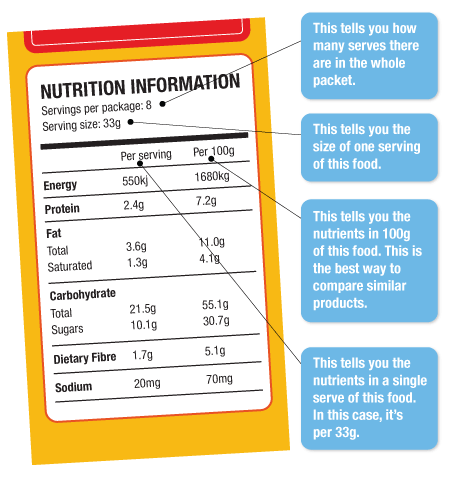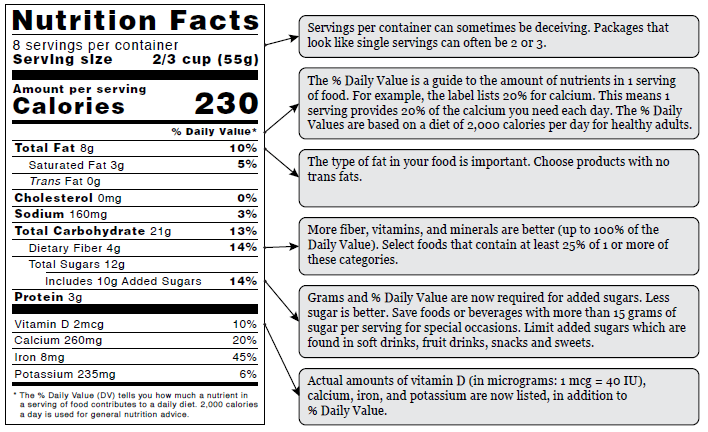39 how to read food labels for sodium content
How to Read a Food Label to Limit Sodium: Care Instructions This will tell you how much sodium is in one serving of food. Look at both the serving size and the sodium amount. The serving size is located at the top of the ... Sodium: How to Read Food Labels - Intermountain Healthcare The content presented here is for your information only. ... Reading food labels can help you monitor how much sodium you are getting in your diet.
How to Read Salt Labels | Cooking Light When food companies make sodium claims, they have to follow labeling rules. For the consumer, the tricky part is that there are four claims. Two apply when a company is comparing their food to a loosely defined fully salted version. One refers to a specific sodium level, another to whether salt has been added.

How to read food labels for sodium content
PDF Read the Nutrition Facts Label for Sodium! - National Institutes of Health the food is high or low in sodium. Choose products with the lowest Percent Daily Value for sodium: 5 percent or less is low, and 20 percent or more is high. Frozen Peas and Carrots One serving (½ cup) of frozen peas and carrots has 125 mg of sodium and 5 percent of the Daily Value for sodium. Canned Peas and Carrots One serving (½ cup) of ... PDF Food Labels and Potassium - American Kidney Fund Reading food labels can help you pick foods and drinks that are high in the nutrients you need and low in nutrients you should limit. Food labels usually tell you the amount of nutrients ... High sodium foods have 20% or greater of your Daily Value per serving. Many packaged and processed foods are high in sodium because they have added salt ... Reading Labels - World Action on Salt & Health Some food labels may only state the sodium content. To convert sodium to salt, you need to multiply the amount by 2.5. For example, 1g of sodium per 100g = 2.5 grams of salt per 100g. You then need to know the weight of the serving portion in grams e.g. 30g. Then divide the concentration of salt per 100g by 100 and multiply by the serving size.
How to read food labels for sodium content. Read food labels - Step 2: Check the sodium content So here is the guideline for checking the sodium content in any packaged food: The sodium content in mg should not be more that the energy in kcal (or ¼ of the energy in kj) With this guideline, we are ready to read some labels. But, before that, let's do some shopping. Assuming that you have not read this blog, and you have not learned ... How to Read a Food Label to Limit Sodium: Care Instructions - Alberta Choose foods with lower % Daily Value and smaller amounts of sodium. Look for foods with 5% Daily Value or lower. Foods with a sodium % Daily Value higher than 15% are high in sodium. Choose these less often. Learn how to use food labels to help you compare similar foods and make healthier choices. Buy low-sodium foods How to Read Food Labels Like a Nutritionist | HUM Nutrition Blog Step 1: Be Wary of Claims. Look at food labels like you're reviewing a potential paramour's online-dating profile. In other words, be skeptical of baiting phrases. (Think terms like "cholesterol free" and "natural.") Studies have shown that consumers are more likely to buy products with health claims, but the truth is that many of ... PDF Reading Food Labels to Look for Sodium - ksw-gtg.com Easy-to-read food labels can help you find foods low in sodium. This will help you keep track of the number of grams (g) or milligrams (mg) you consume each day. According to Food and Drug Administration regula- tions, no manufacturer can say that their product is "low-sodium" unless they can prove that claim.
Sodium: How to Read Food Labels - Intermountain Healthcare A food low in sodium should have about 140 milligrams or less per serving. The ingredients list will show you every ingredient in the product. The higher an ingredient appears on the list, the larger the percentage of that ingredient is in the food. If any of the following items appear at the top of the list, How do you read a food label for salt / sodium? If the salt content is not available on a label you can calculate it from the sodium content using the following: Sodium x 2.5 = salt content or Salt ÷ 2.5 = sodium content If you have kidney disease a good goal for sodium intake is 2300 mg of sodium or 6g salt per day. Understanding Food Nutrition Labels | American Heart Association 1 - Start with the serving information at the top. This will tell you the size of a single serving and the total number of servings per container (package). 2 - Next, check total calories per serving and container. Pay attention to the calories per serving and how many calories you're really consuming if you eat the whole package. Sodium and Food Labels | Sutter Health This is an example of a typical food label. It's important to note that all nutritional labels list amounts of nutrients per serving. This item, for example, lists 16 servings in the entire container. The sodium level is 120 mg for one serving. That means if you drink the entire container, you'll get 1,920 mg sodium!
Learning To Read Labels :: Diabetes Education Online On a nutrition food label, subtract the fiber from the total carbohydrate amount. When you read food labels, the grams of sugar are already included in the total carbohydrate amount, so you do not need to count this sugar amount separately. The grams of sugar listed include both natural sugars, from fruit or milk, and added sugars. How to read food labels: MedlinePlus Medical Encyclopedia If a label says that a food has 100 mg of sodium, this means it has about 250 mg of salt. You should eat no more than 2,300 mg of sodium per day. This is the amount of sodium that is in 1 measuring teaspoon of table salt. Ask your health care provider if you should have even less. The % daily value is included on the label as a guide. Sodium & Your Heart Health: How To Read Nutrition Facts On Food Labels Food can be considered low-sodium if the total sodium content is 140mg or less and is based on serving size. Overindulging on the portions with a low-sodium food can potentially be just as detrimental as eating a food that's high in salt. Additionally, people shopping for low-sodium foods should opt for packaging that features a 5% DV or lower. How to Understand and Use the Nutrition Facts Label | FDA It can tell you if a serving of food is high or low in a nutrient and whether a serving of the food contributes a lot, or a little, to your daily diet for each nutrient. Note: some nutrients on the...
PDF Controlling Sodium and Reading Labels - Veterans Affairs 2) Check sodium content. Use food labels and packaging to help you select the lowest sodium option. If unable to buy low sodium versions, drain and rinse canned foods under running water to remove excess sodium. • Choose foods with 140 mg sodium or less per serving. • Avoid food with more than 300 mg of sodium per serving.
Food labels - NHS Nutrition labels can help you choose between products and keep a check on the amount of foods you're eating that are high in fat, salt and added sugars. ... (or 0.6g sodium) Low: 0.3g of salt or less per 100g (or 0.1g sodium) For example, if you're trying to cut down on saturated fat, eat fewer foods that have more than 5g of saturated fat per ...
Reading a Label for Sodium Content Reading a label for sodium content is never necessary when you're using fresh meat, fresh rice, and fresh vegetables in the food prep process. Substitute cured foods for those that are fresh instead. Skip the ham, bacon, lox, olives, and sauerkraut in favor of fresh veal, pork fish, and eggs. Choose low-salt deli meats — reading a label for ...
Reading food labels: Tips if you have diabetes - Mayo Clinic Put sugar-free products in their place. Sugar-free doesn't mean carbohydrate-free. Sugar-free foods may play a role in your diabetes diet, but remember that it's equally important to consider carbohydrates as well. A sugar-free label means that one serving has less than 0.5 grams of sugar. When you're choosing between standard products and ...
How to Read a Food Label to Limit Sodium: Care Instructions Look at both the serving size and the sodium amount. The serving size is located at the top of the label, usually right under the "Nutrition Facts" title. The amount of sodium is given in the list under the title. It is given in milligrams (mg). Check the serving size carefully.
Sodium on the Nutrition Facts Label | FDA - U.S. Food and Drug ... FDA's Education Materials Sodium in Your Diet Fact Sheet A printable backgrounder that offers the basics on sodium's health effects, easy how-to's for using the Nutrition Facts label to reduce...
How to Decode Salt on Food Labels: Low Sodium vs Reduced Sodium vs ... These foods have at least 25% less sodium than their original version. "Light in sodium" or "lightly salted" items are reduced by 50%. Unlike low sodium foods, reduced sodium foods can still be swimming in sodium. (One reduced-sodium soup we saw packs 660 mg per serving!) Keep an eye out for reduced sodium soups, reduced sodium chicken ...
How to Read Sodium Percentages on Food Packages A "very low sodium" product must have less than 35 milligrams of sodium, while a "low sodium" product must have less than 140 milligrams of sodium. All in the Name Along with reading the food...




Post a Comment for "39 how to read food labels for sodium content"